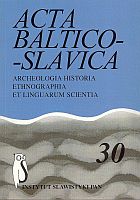Формирование зональной группировки белорусских говоров и проблема славяно-балтских языковых отношений
Forming Zonal Grouping of Belarusian Dialects and Problem of Slavic and Baltic Language Interaction
Author(s): Vera AstrejkaSubject(s): Language and Literature Studies
Published by: Instytut Slawistyki Polskiej Akademii Nauk
Keywords: linguistic landscape; dialect zone; Slavic and Baltic language interaction; contact zone; language substratum; areal development
Summary/Abstract: Cultural and historical interaction of Belarusians and their ancestors with neighbouring Slavic and non-Slavic ethno-national communities for various historical periods is the main reason of formating the zonal grouping in Belarusian. The Slavic (later on Belarusian) and Baltic language contacts and correlations take the most important place in this process. The article first deals with the role of Baltic ethnic and lingual component in forming Belarus zonal linguistic landscape on the whole and every dialect zone of Belarusian in particular. In the work reasons and main ways in development of zone language phenomena of Baltic origin are noted and their general geolinguistic characteristics are given. The investigation is first of all grounded on geolinguistic methods, elements of descriptive and analitic, contrastive-comparative and etymological ones are also used. Analysis of peculiarities of presented language facts geography in Belarusian, comparative study of isoglosses and their next interpretation, comparison of linguistic data with historical and archaeological ones helped not only to reveal principal historical and genetic factors in forming zonal structural and territorial groups in Belarusian, but to reconstruct common picture of Slavic and Baltic ethnical and language interaction in Belarus in the past. It’s very important for solving the problem of Belarusian dialectal continuum formation and the origin of the Belarusians as a separate Slavic nation. So the following conclusions were made. Most of the Baltiсisms (lexical, grammatical etc.) in Belarusian are zonal phenomena. These are registered mostly within the northwest dialectal zone, which is a part of the modern Baltic and Slavic contact area. Some other zone isoglosses were formed as a result of areal moving from the contact zone. But geographical distribution of the Baltizms is often linked to the chronology of their appearance in Belarusian or its predecessor. A lot of the language facts are the evidences of early contacts of the ethnogenetic dialect base of Belarusian with different Baltic dialects. There are substratum phenomena or Baltic loans adopted in the late Proto-slavic period among them.
Journal: Acta Baltico Slavica
- Issue Year: 2006
- Issue No: 30
- Page Range: 333-344
- Page Count: 12
- Language: Russian

